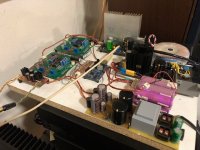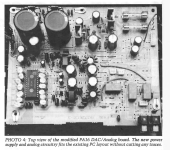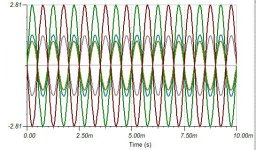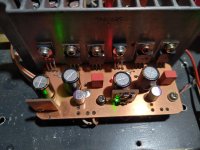Hi grunf,I have been listening this amplifier for little less than a month and I must admit that the AD811 is an ideal partner for it, without any preamplifier, the output is only connected via 10K ALPS, again without any capacitors and I must admit that the sound is better than with Le Monstre.
The surprises never end 🙂
Is this statement referring to the JLH?
But those (PNM, PTN) are thin film smds not tantalumsI am slowly switching all the important resistors in my designs to tantalum versions, namely the PNM and PTN series from Vishay.
I doupt that I'd hear much difference changing that kind of quality resistors (RN60s) in a reg. Hope it made sense to your ears, curious about what change they brought. At least they are cheap.
Vishay seems to be rather cryptic but the graph of Yageo's ones shows that it's the actual resistive layer. Was expecting something like Audio Note's tants which cost an arm and a leg. The good thing is their Temp Co is very low, 25ppm and below. Still, for psu, RNs 50/100 ppm is good enough for me, it wouldn't accure to me to make a comparison but apparently there are some inquisitive souls out there and is proven to be one of them 


No , I'm thinking of a 'ceci est un Cube' amplifier, JLH69 has a capacitor at the input.Hi grunf,
Is this statement referring to the JLH?
No, that DAC will have all the regulators right up to the PCM1794 on the same PCB.But it will be some time before I embark on that adventure.Are these for PCM1794 already?
In all my regulators, regardless of whether they are shunt or series, replacing resistors with tantalum resistors in key positions around the op amps has brought a change in sound. The same change is felt in the references.Vishay seems to be rather cryptic but the graph of Yageo's ones shows that it's the actual resistive layer. Was expecting something like Audio Note's tants which cost an arm and a leg. The good thing is their Temp Co is very low, 25ppm and below. Still, for psu, RNs 50/100 ppm is good enough for me, it wouldn't accure to me to make a comparison but apparently there are some inquisitive souls out there and is proven to be one of them
View attachment 1384384
It all started with replacing RN60 around AD811 and today I already have amplifier made completely with tantalum resistors.
Whether the difference is in the material itself, i.e. tantalum, or in non-inductance or non-magnetic, I don't know, but I can certainly say that they are better than RN60 or Vishay MELFs, which are also known as excellent resistors in the RN range.
In short, the change is as if you took the curtain off the speaker, a completely new dimension of sound.
To this day, the AD811’s combination of specs. seems unique (slew-rate, settling-time, low 1/f noise, low distortion even driving a 100 Ohm load, and a few others) seem to place it in a position by itself for audio DAC, feedback-based I/V application.
But that more than 1K R input is not what we want for an I/V at first item of the wisch list. You don't care of the load to drive as buffer exists (if you talked of the next load). But most of the op amp are worse here (I mean Z input wise)
I'm glad you're happy with the sound of the AD811. Unfortunately, that CFA op amp was forgotten in the audio world for years and is now experiencing its renaissance again.Hi, today I started AD811 on TDA1541 D3 and I'm surprised how nice it plays, I've tried tubes, transformers, but this is the best sound for me. I don't have a proper source yet.
In support of that, here's a photo from 32 years ago from Audio Amateur(2/92) when Gary Galo, Walt Jung and Hampton Childress modified a Philips DAC960, naturally with an AD811 🙂 .
Attachments
Honestly, I forgot about the tubes and the other op amps in the DAC , all because of the AD811😀.
dsc2 +-8mA -> OPA1633 differential i/v -> ina849 diff/se -> mfb -> tone control -> se/diff , dc coupled.
Attachments
Last edited:
I have a small problem with the availability of IXTP08N100D2. Can IXTP08N100P be used as its replacement?
@pjasio253 ,IXTP08N100P is a enhancement mode mosfet , Mouser currently has the IXTP08N50D2 so you can feel free to use it 😉 .
Last edited:
- Home
- Source & Line
- Digital Line Level
- AD811 as I/V stage for current DACs (and test some other opamps including Burson Audio opamps as I/V)



